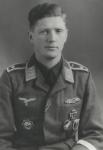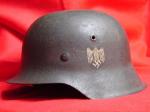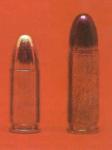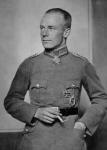-
Posts
722 -
Joined
-
Last visited
Content Type
Profiles
Forums
Blogs
Gallery
Events
Store
Everything posted by Douglas Jr.
-
Hi John, You can check the award criteria for the Ground Assault Badge here: http://www.wehrmacht-awards.com/war_badges...sault_badge.htm For the Flak Badge here: http://www.wehrmacht-awards.com/war_badges...Flak_badge1.htm For sure the Ground Assault Badge was given to FJ, as well, of course, flak troops. Douglas.
-
THE 22 APRIL 1945 - DAY OF THE BRAZILIAN FIGHTER ARM The day dawned cold, overcast and foggy. The three flights took off at 5 minute intervals starting at 8:30 AM, to attack targets in the San Benedetto region, destroying bridges, barges and motorized vehicles. At 10:00 AM, a flight took off for an armed reconnaissance mission south of Mantua - more than 80 trucks and vehicles were destroyed. Other aircraft attacked fortified German positions, tanks and barges.By the end of the day, the Group had flown 44 individual missions, having destroyed more than a hundred vehicles as well as barges, etc. Two P-47s were damaged and a third was shot down, its pilot, 2? Ten.-Av. Armando de S. Coelho being taken prisoner. This was the day when more sorties than ever were made by the Group, and is commemorated each year as the Brazilian Fighter Arm Day. (Brazilian pilots are awarded with the Air Medal, 1945) THE RESULTS The 1?GAVCA flew a total of 445 missions, 2,550 individual sorties and 5,465 combat flight hours, from 11 November 1944 to 4 May 1945. The XXII Tactical Air Command acknowledged the efficiency of the Group by noting that, between 6 to 29 April 1945, it flew only 5% of the total of missions carried out by all squadrons under its control, but destroyed: 85% of the ammunition depots, 36% of the fuel depots, 28% of the bridges (19% damaged), 15% of motor vehicles (13% damaged) and 10% of horse-drawn vehicles (10% damaged). The actions of the 1?GAVCA during the Italian Campaign were even more exhalted on 22 April 1986. On that day the Group received, from the Mr. Ambassador of the USA to Brazil, together with the Secretary for the USAF, the Presidential Unit Citation (Air Force), given by the US Government. It is with pride that we acknowledge that, apart other few USAF units, only the 1?GAVCA and two Royal Australian Air Force units - Nos. 2 and 13 Squadrons - have received this citation. "Their deeds will remain alive while men fly. Their victories in the battlefields will be in our hearts while courage and heroism are treasured by men ." E. Aldridge Jr., Secretary for the USAF, at the bestowing ceremony of the Presidential Unit Citation to the 1?GAVCA Hope you enjoy it! Regards, Douglas.
-
THE GROUND CREWS In every air combat unit, the ground personnel - mechanics, armourers, radio technicians, intelligence officers, supply men, medics and nurses - are those that make every effort so that a few men - the pilots - are able to carry out the missions attributed to them. The 1?GAVCA was no exception, having had at its disposal more than 300 men. Commanded by Maj.-Av. Marcilio Gibson Jacques, who showed the utmost ability to organize and communicate with the personnel under his orders, they performed the daily tasks of maintenance with strong determination and dedication to duty - as a result, the Group had a high rate of serviceability. A group of doctors and nurses were also sent to Italy. Among them was Ten.-Med. Luthero Vargas, son of the then Brazilian president, Get?lio Vargas. Some of the doctors served with the US 12th General Hospital at Livorno, while Cap.-Med. Thomas Girdwood was attached to the Group - he was the first FAB "squadron doctor", although at that time such an appointment did not exist. Six nurses - 2? Tenentes Isaura, Antonina, Judith, Ocimara, Regina e Diva - were attached to the 1?GAVCA since the training in the U.S.A. until the end of the war. THE 1?GAVCA SONG During the Carnival of 1945, some pilots created the song "Carnival in Venice" after a bombing mission on that town. This song became the Brazilian fighter pilots song after the war. COMBAT MISSIONS The Brazilian pilots had been trained in the US for fighter operations -- but the Luftwaffe had by then nearly no airplanes in Italy! Thus the 1?GAVCA started its fighting career as a fighter-bomber unit, its missions being armed reconnaissance and interdiction, in support of the US 5th Army, to which the Brazilian Expeditionary Force was attached. On 16 April 1945, the US 5th Army started its offensive along the P? Valley. On this date, the Group was reduced to 25 pilots, some having been killed and others, having been shot down, becoming POWs. Also, some had been relieved from operations on medical grounds due to combat fatigue. The Yellow flight was thus disbanded, its remaining pilots being distributed among the other flights. Each pilot flew on average two missions a day. On the 19 April, the German frontline was broken, this having been first signalled to Command HQ by the Group. The Allied forces had to set up a bridgehead across the River P?, before the German forces crossed it. This was to be done on the 23 April, after a softening up of the German defences by the Air Force on the previous day. (Above: 2nd Lieutnant Renato Goulart Pereira with his P-47 during the Italy Campaign, 1945. He flew 94 combat missions between November, 1944 and April 30th, 1945. Among many decorations, Goulart was awarded with the Distinguished Flying Cross with two Oakleaves and Air Medal with four oakleaves. He is still alive.)
-
IN ACTION! The Brazilian pilots initially flew from 31 October 1944 as individual elements of flights of the 350th FG US squadrons, at first in affiliation flights and progressively taking part in more dangerous missions. Less than two weeks later, on 11 November, the Group started its own operations, flying from its base at Tarquinia, using its call-sign Jambock. The Group was divided into four flights, Vermelha (Red), Amarela (Yellow), Azul (Blue) and Verde (Green).Each flight had a complement of roughly 12 pilots, these having been flying together since their training spell in Panama. A pilot customarily wore an echarpe in the colours of his flight. The CO of the Group and some officers were not attached to any specific flight. The Thunderbolt colour scheme Initially the P-47s were finished in standard US fighter colours, olive-drab (top surfaces) and neutral grey (undersurfaces) (except those aircraft of the commander and operations officer which were finished in natural metal and olive-drab anti-glare panels). The badge of the Group was painted just after the engine cowling, and the aircraft code (flight letter-aircraft number) was in white letters over the cowling. National insignia was in four positions, this being the US star-and-bar, with the white star replaced by the Brazilian star. Later, replacement aircraft were in natural metal, with olive-drab anti-glare panels, the codes being in black (click here for some pictures of the colour schemes). (Above: US Captain John C. Buyers served as US liasion officer with the Brazilian Fighter Group during the Italy Campaign. He even flew several combat missions with the Brazilians pilots) (Above: Leutnant Roberto Tormin Costa, who flew 65 combat missions during the campaign. Among other decorations, he was awarded with the Distinguished Flying Cross, Air Medal and the Presidential Unit Citation. He died at age of 22 in a plane crash in April, 1946).
-
Hi folks, Here a short history about the FAB (For?a A?rea Brasileira - Brazilian Air Force) during the Italy Campaign. As very few people know that South Americans saw combat in the ETO, I think you all may like it. The 1? Grupo de Avia??o de Ca?a in Italy, 1944-1945 Formed on 18 December 1943, the 1?GAVCA had its cadre composed of volunteer FAB (For?a A?rea Brasileira) pilots. Its Commanding Officer was Ten.-Cel.-Av. Nero Moura. The Group had 350 men, including 43 pilots, and was sent to Panama for combat training, since the pilots already had flying experience -- one of its pilots, 2? Ten.-Av. Alberto M. Torres, was the pilot of the PBY-5A Catalina that had sunk the U-199. There, the Group suffered its first casualty -- 2? Ten.-Av. Dante Isidoro Gastaldoni (KIFA).On 11 May 1944, the Group was declared operational and became active in the air cover in the Canal Zone, equiped with the Curtiss P-40. Following the completion of its initial training, the Group was sent to the USA on 22 June for an operational conversion course on to the Republic P-47D Thunderbolt that was to equip the 1?GAVCA. The Group departed to Italy on 19 September 1944, arriving at Livorno on 6 October. There it became part of the 350th Fighter Group USAAF, an unit which had been formed on 1 October 1942 in Britain. Several of its first pilots had served previously with the Royal Air Force or the Royal Canadian Air Force. After the Allied landings in Northern Africa (Operation "Torch"), the 350th FG was transferred to that region and followed the Allied invasion of Italy. Until the arrival of the 1?GAVCA, the 350th FG was made up of three squadrons: 345th Fighter Squadron ("Devil Hawk Squadron"), 346th FS ("Checker Board Squadron") and 347th FS ("Screaming Red Ass Squadron"). When the 1?GAVCA - or, rather, the 1st Brazilian Fighter Squadron - 1st BFS - was incorporated to the 350th FG, that unit was subordinated to the 62nd Fighter Wing, XXII Tactical Air Command, 12th Air Force USAAF. The call-signs for each of the Groups component squadrons were: 345th FS, "Lifetime"; 346th FS, "Minefield"; 347th FS, "Midwood"; and 1st BFS, "Jambock" THE BADGE OF THE 1?GAVCA The badge of 1?GAVCA was designed while the Squadron was travelling to Italy aboard the transport ship UST Colombie by a group of its pilots, Ten.-Av. Rui Moreira Lima, Ten.-Av. Jos? Rebelo Meira de Vasconcelos, Ten.-Av. Lima Mendes and Cap.-Av. Fortunato C. de Oliveira. Drawn by the latter, it can be described as follows, according to its author: - The green-yellow surrounding represents Brazil; - The red field behind the fighting ostrich represents the war skies; - The bottom field - white clouds - represents the ground to a pilot; - The blue shield charged with the Southern Cross is the common symbol for the Brazilian Armed Forces; - The ostrich represents the Brazilian fighter pilot, whose face is inspired in that of Ten.-Av. Lima Mendes, and also the stomach of the veterans of 1?GAVCA; - The white cap was part of the FAB uniform at the time and distinguished the Brazilian pilots from the other Allied pilots; - The gun being hold by the ostrich represents the firepower of the P-47, with its eight .50in machine-guns; - The motto "Senta a Pua!" is the war cry of 1?GAVCA; - The white streak, at the right, ending on a flak burst, was added later, and represents the danger brought by the German anti-aircraft artillery to the pilots (this device appeared only on replacement aircraft). The use of an ostrich to represent the Brazilian fighter pilots comes from the fact that, during the early Forties, several Brazilian aircrew went to the USA to fly back to Brazil the aircraft then being bought in large numbers by the Brazilian authorities, not only training but also combat aircraft. During their stay in that country, they got acquainted to American food: baked beans, powder eggs and powder milk, among other items. The then Cel.-Av. Geraldo Guia de Aquino dubbed the pilots "ostrichs" and the nickname caught. The war cry "Senta a Pua!" was a suggestion from Ten.-Av. Rui who had heard it several times from Cap.-Av. Firmino Alves de Araujo while serving at Salvador Air Base; it was used by the latter on his subordinates, inviting them to do their tasks at once and quickly. It became the Brazilian equivalent of the British Tally-Ho and the French "A la Chasse!".
-
Hi folks! Nice specimen you have here! Well, I?m not a helmet collector but how can you say that you collect Germann stuff if you don?t have a single helmet?!? So I?ve been adding a few to my collection. So here is my M42 SD Heer, ET 64 with rough finish. I simply loved its "WAS THERE" look! Douglas.
-
Thanks for the explanation, Rick! But still looks like a pidgeon?s nest to my blurred eyes. Just kidding! Douglas.
-

Kriegsmarine Minesweeper badge
Douglas Jr. replied to Dave B's topic in Wehrmacht Medals, Decorations & Awards
Hey! Some guys here are really graphic artists! Here is my contribution. A "R.S." marked Minesweeper Badge. Sorry for the so-so image. Douglas. -
hi joe and byf, Thanks for your kind comments! Concerning the ammo it is not the 9mm Luger (or 9mm Parabellum). It is a completely different ammo (hence the gun?s rarity) called 9mm Mauser Export. Below I put a picture of the latter (on right) when compared with the 9mm Luger (on left). As I said, it was a nice and powerful amunition. But it very scarce today. All the best, Douglas.
-
Hi folks, During the first semester of this year I purchased a 2nd Model LW Dagger, for a nice price (I?m not a dagger guy but the price was good). As it is my only dagger I decided to build a display around it. I started to buy some items connected to Luftwaffe and when I put everything together, I finally see that it could be named as ... "STUKA Display". The Stuka is the natural choice mainly because of the Silver Clasp for Bomber and, sure, the "Immelmann Geschwader" cufftitle. For those not familiar with the unit, this was the honor name for the Stukageschwader 2 (St.G 2), later renamed Schlachtgeschwader 2 (SG 2). Its most famous pilot was, of course, Hans-Ulrich Rudel. The box is a modified display for jewelry with glass top. Hope you enjoy it this humble display. Douglas.
-
Paul, Thanks again! It is a little bit difficult to get an image of the maker?s mark but here is the best I could get. It is the typical "A" from this maker. Douglas.
-
Terry, Finally somebody say it! Although I respect everyone?s opinion, sometime some suppositions became holy true, without any very strong proofs. I know that elsewhere I could be crucified for saying this but I always think that we have to have in mind that any mass production process always has variations in the final products. This is frequently overlooked by "experts" and good pieces can be easily burned for this judgement. Just my opinion. Douglas.
-
Hi folks, Here is my latest medal bar. It arrived at home last week. It is a Bavarian Junior Officer medal bar marked DRGM (with matching ribbon bar) with the Military Merit Order of 2nd Class with swords - something that I was looking for . The bar brings the following awards: - Iron Cross 2nd Class (1914) - Bavarian Military Merit Order 2nd Class with Swords - Cross of Honor for Fighters 1914-1918 - Bavaria 12 years Military Service Medal (correct me if I?m wrong...) - Tyrol WWI Commemorative Medal. Hope you enjoy it. Douglas.
-
OK. Here is one of mine: a late war zinc Pilot?s Badge made by Assmann. Douglas.
-
This ammo ? which I don?t have an example up to now ? is one of the most powerful 9mm ever made. Here is some information about this incredible ammunition (which makes me wonder why it is not produced nowadays): Round length ? 35,00 mm (1.378in) Case length ? 25,00mm (0.981in) Bullet weight ? 127 gr (8,23g) Muzzle velocity ? 1,362 ft/sec (415m/s) Muzzle energy ? 523 ft/lb (707J) Hope you enjoy it. Douglas.
-
The magazine follower in all 9mm Mauser Export pistols has a short indentation milled into its upper surface, to facilitate feeding the straight-cased cartridge. Other typical characteristic of the pistols chambered for this ammo (the latter batch, around the 170.000 serial number) is the difference in the shape of the chamber area, on which the flats are brought a further forward than on any other model except the carbines. This was apparently an effort to strengthen the chamber for the long and powerful 9mm Mauser Export.
-
The gun that I show now is in the latter batch. Pay attention to the rarely seen (and beautiful) black hard rubber grips with the Mauser monogram. I must to confess that it was the main reason to get this one ? crazy, isn?t it? Believe me: the photos do not make justice to this piece...
-
Hi folks, I?m back with a interesting addition that I made some months ago. It seems that not many people enjoy the odd-looking but very interesting Mauser C-96 around here (just kidding!) but I?d like to share this one with you all, even though it was a non-military gun. So here we go? This is a rare Commercial Mauser C-96 chambered to fired the seldom seen 9mm Mauser Export cartridge. According to Breathed & Schroeder?s book ?System Mauser? (pages 118-119 and 122-123) very few were made, mostly being around the serial range 80.000-90.000 and, later, around the 170.000 range.













